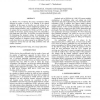Free Online Productivity Tools
i2Speak
i2Symbol
i2OCR
iTex2Img
iWeb2Print
iWeb2Shot
i2Type
iPdf2Split
iPdf2Merge
i2Bopomofo
i2Arabic
i2Style
i2Image
i2PDF
iLatex2Rtf
Sci2ools
ICASSP
2010
IEEE
2010
IEEE
Energy-aware adaptive OFDM systems
An effective way of reducing the energy consumption without affecting the quality of service is by adapting to the channel conditions. In this paper we describe one such scheme for an OFDM system using space division multiplexing technology. We consider tuning parameters such as modulation level and number of antennas that are considered by WiMax and LTE, as well as number of sub-carriers, peak to average power ratio, interpolation, pilot length and cyclic prefix. We describe a two-phase procedure for determining the parameter settings for minimizing energy consumption given the transmission rate, error performance and channel conditions for frequency selective fading channels. Our results show that we can reduce energy by an additional 5%-30% compared to systems that can only adapt modulation order and number of antennas.
| Added | 11 Feb 2011 |
| Updated | 11 Feb 2011 |
| Type | Journal |
| Year | 2010 |
| Where | ICASSP |
| Authors | Yunus Emre, Chaitali Chakrabarti |
Comments (0)

